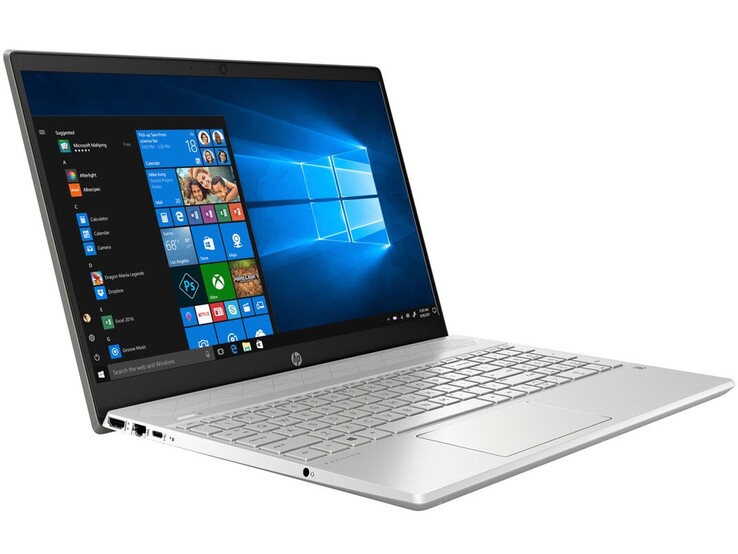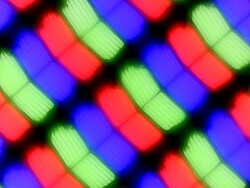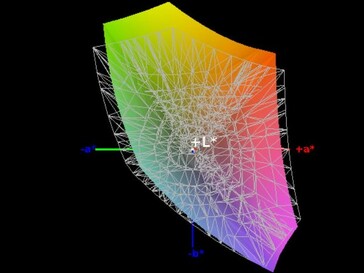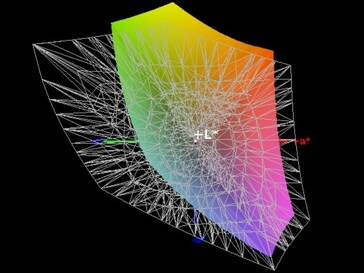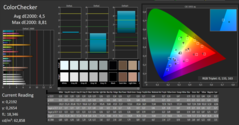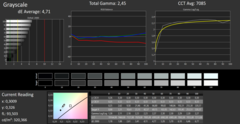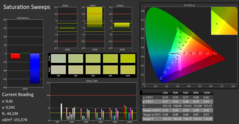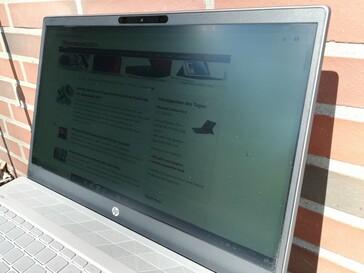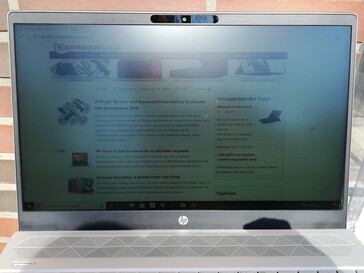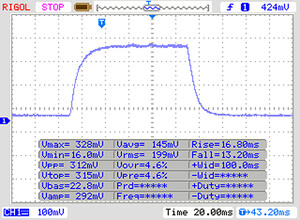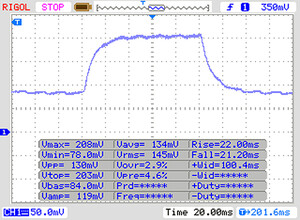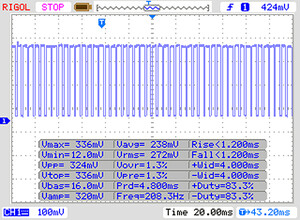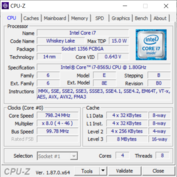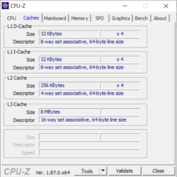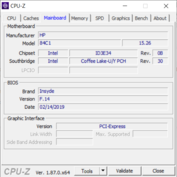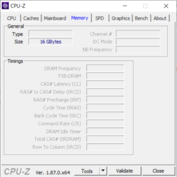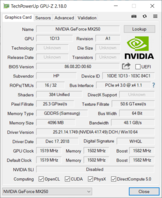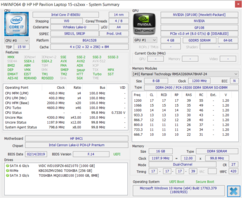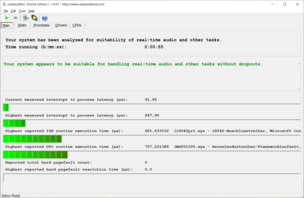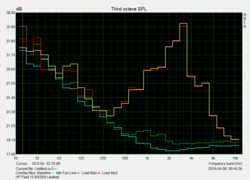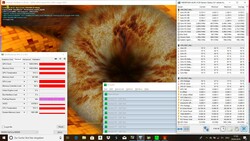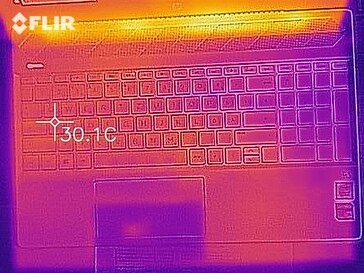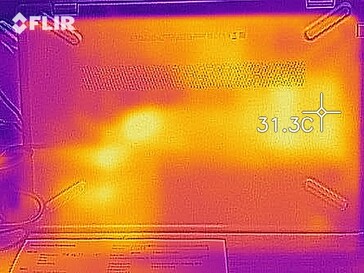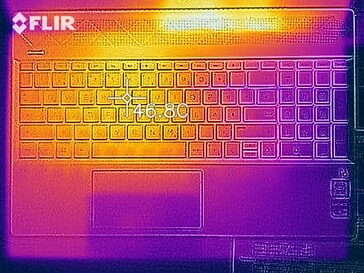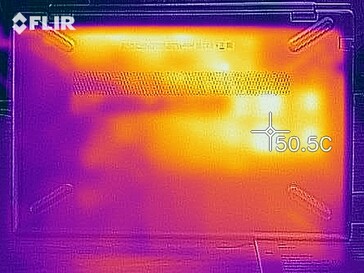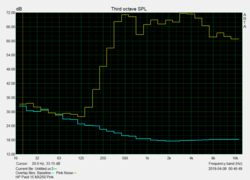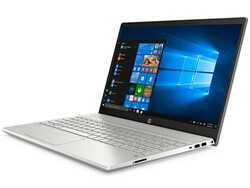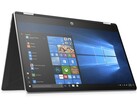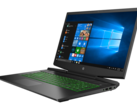HP Pavilion 15 (Core i5-8265U, GeForce MX250, 16 GB RAM) Laptop Review

HP continues to remain true to its shift towards releasing stylishly designed laptops whatever the screen size. The Pavilion 15-cs2019ng embodies this ethos and is the Whiskey Lake version of the Kaby Lake-powered Pavilion 15-cs0003ng and the Pavilion 15-cw0003ng with its AMD processor. HP also sells an identical version but with a 14-inch display rather than the 15.6-inch panel that the Pavilion 15 has. The company markets this smaller model as the Pavilion 14-ce0002ng, for reference. Our current review unit looks visually identical to its siblings, so please see our Pavilion 15-cs0003ng, Pavilion 15-cw0003ng and Pavilion 14-ce0002ng reviews for our detailed thoughts on the case, connectivity, and any other subjects we only cover briefly in this review.
HP equips our current test device with an Intel Core i5-8265U processor, 16 GB RAM, a 256 GB SSD and a 1 TB HDD, for which it currently charges approximately 1,100 Euros (~$1,240). The Pavilion 15 also packs an Nvidia GeForce MX250 GPU, which succeeds the popular GeForce MX150. The GeForce MX250 has slightly higher clock speeds than its predecessor so it should deliver better overall performance in our tests.
We have chosen to compare the Pavilion 15 against not only its siblings but also other comparably priced 15.6-inch laptops. Our comparison devices will include the Acer Aspire 5 A515, ASUS VivoBook S15 and the slightly more powerful MSI PS63 Modern 8RC.
Case
The cs2019ng's case looks identical to that of the Pavilion 15-cs0003ng. Both devices weigh the same and have matching dimensions. Please see our review of the latter for our full thoughts on the Pavilion 15's case.
Connectivity
The cs2019ng has a decent selection of ports that should be enough for most people. The inclusion of a USB Type-C port is handy too and allows you to connect missing ports with appropriate adapters should you need to do so.
SD Card Reader
HP has equipped our review unit with the same SD card reader as its siblings, which achieves lower than average transfer speeds with our Toshiba Exceria Pro SDXC 64GB UHS-II reference card. The Pavilion 15 is slightly faster than the VivoBook S15 and the MSI PS63 Modern 8RC here too, for reference.
| SD Card Reader | |
| average JPG Copy Test (av. of 3 runs) | |
| Average of class Multimedia (21.1 - 198, n=41, last 2 years) | |
| Acer Aspire 5 A515-52G-723L (Toshiba Exceria Pro SDXC 64 GB UHS-II) | |
| HP Pavilion 15-cw0003ng (Toshiba Exceria Pro SDXC 64 GB UHS-II) | |
| HP Pavilion 15-cs2019ng (Toshiba Exceria Pro SDXC 64 GB UHS-II) | |
| HP Pavilion 15-cs0003ng (Toshiba Exceria Pro SDXC 64 GB UHS-II) | |
| Asus VivoBook S15 S530UN-BQ097T (Toshiba Exceria Pro M501 64 GB UHS-II) | |
| MSI PS63 Modern 8RC (Toshiba Exceria Pro SDXC 64 GB UHS-II) | |
| maximum AS SSD Seq Read Test (1GB) | |
| Average of class Multimedia (27.4 - 262, n=41, last 2 years) | |
| Acer Aspire 5 A515-52G-723L (Toshiba Exceria Pro SDXC 64 GB UHS-II) | |
| HP Pavilion 15-cw0003ng (Toshiba Exceria Pro SDXC 64 GB UHS-II) | |
| HP Pavilion 15-cs0003ng (Toshiba Exceria Pro SDXC 64 GB UHS-II) | |
| HP Pavilion 15-cs2019ng (Toshiba Exceria Pro SDXC 64 GB UHS-II) | |
| Asus VivoBook S15 S530UN-BQ097T (Toshiba Exceria Pro M501 64 GB UHS-II) | |
| MSI PS63 Modern 8RC (Toshiba Exceria Pro SDXC 64 GB UHS-II) | |
Communication
The cs2019ng supports all modern Wi-Fi standards up to IEEE 802.11ac and can connect to 2.4 or 5 GHz networks. The device also has a 2x2 MIMO antenna to help maximise the transfer speeds of its Intel Wireless-AC 9560 Wi-Fi module. Our review unit averaged an impressive 676 Mb/s in our iperf3 Client download test and 562 Mb/s in the corresponding upload test. The cs2019ng wipes the floor with its siblings here and finished top of the download test with the PS63 Modern 8RC 4% slower in second place. Our review unit’s fourth-place finish in the upload test is still respectable too.
Accessories
HP only includes a 65 W power supply in the box and some literature including warranty information and a quick-start guide. The company does not sell any Pavilion 15 specific accessories, but you can purchase external keyboards, mice, speakers and much more in the company's online store.
Maintenance
The cs2019ng has limited maintenance options. The SSD and HDD are replaceable, but you must remove the bottom plate to access them, which is a pain to remove. You must loosen all the screws securing the bottom plate to the case, including those hidden beneath the device’s long and fragile rubber feet, before carefully prying up numerous plastic clips that are easily breakable. In short, we would recommend against removing the bottom case unless you are an experienced user.
Warranty
The Pavilion 15 comes with 12 months manufacturer’s warranty, but this could be extended with an HP Care Pack should you need longer warranty coverage.
Please see our Guarantees, Return Policies & Warranties FAQ for country-specific information.
Input Devices
HP also equips the cs2019ng with the same keyboard and trackpad as its predecessors. Hence, please see our other Pavilion 15 reviews for our thoughts on those components.
Display
The cs2019ng has a 15.6-inch IPS panel like its siblings that also operates natively at 1920x1080. HP has equipped our review unit with a BOE080D panel, which is different to the ones that we have seen in our Pavilion 15 test devices.
Our review unit gets brighter than its siblings and achieved an average maximum brightness of 293 cd/m², which is brighter than our other comparison devices too. The display is only 86% evenly lit though, which is worse than most of our comparison devices.
Disappointingly, the cs2019ng uses pulse-width modulation (PWM) to regulate display brightness, which can cause eye strain and headaches for some people. The display in our review unit flickers at 208 Hz with it set to 90% brightness and below, for reference. This frequency is low enough to cause those who have sensitive eyes some issues, especially those who are PWM sensitive.
| |||||||||||||||||||||||||
Brightness Distribution: 86 %
Center on Battery: 273 cd/m²
Contrast: 1231:1 (Black: 0.26 cd/m²)
ΔE ColorChecker Calman: 4.5 | ∀{0.5-29.43 Ø4.78}
ΔE Greyscale Calman: 4.71 | ∀{0.09-98 Ø5}
88% sRGB (Argyll 1.6.3 3D)
58% AdobeRGB 1998 (Argyll 1.6.3 3D)
64.4% AdobeRGB 1998 (Argyll 3D)
88.1% sRGB (Argyll 3D)
67.2% Display P3 (Argyll 3D)
Gamma: 2.45
CCT: 7085 K
| HP Pavilion 15-cs2019ng BOE080D, , 1920x1080, 15.6" | Acer Aspire 5 A515-52G-723L BOE NV156FHM-N48, , 1920x1080, 15.6" | Asus VivoBook S15 S530UN-BQ097T LP156WFC-SPD1, , 1920x1080, 15.6" | MSI PS63 Modern 8RC Chi Mei CMN15E8 N156HCE/EN1, , 1920x1080, 15.6" | HP Pavilion 15-cw0003ng AU Optronics AUO23ED, , 1920x1080, 15.6" | HP Pavilion 15-cs0003ng 1920x1080, 15.6" | |
|---|---|---|---|---|---|---|
| Display | -37% | -38% | -2% | -41% | -42% | |
| Display P3 Coverage (%) | 67.2 | 40.02 -40% | 38.51 -43% | 63.5 -6% | 36.7 -45% | 36.27 -46% |
| sRGB Coverage (%) | 88.1 | 58.5 -34% | 57.9 -34% | 87.9 0% | 55 -38% | 54.6 -38% |
| AdobeRGB 1998 Coverage (%) | 64.4 | 41.34 -36% | 39.79 -38% | 63.9 -1% | 37.91 -41% | 37.47 -42% |
| Response Times | -10% | 9% | -4% | 9% | -1% | |
| Response Time Grey 50% / Grey 80% * (ms) | 43 ? | 45 ? -5% | 38.8 ? 10% | 42 ? 2% | 40 ? 7% | 45 ? -5% |
| Response Time Black / White * (ms) | 29 ? | 33 ? -14% | 26.8 ? 8% | 32 ? -10% | 26 ? 10% | 28 ? 3% |
| PWM Frequency (Hz) | 208 ? | 250 ? | 25000 ? | |||
| Screen | -6% | -12% | 9% | -16% | -37% | |
| Brightness middle (cd/m²) | 320 | 278 -13% | 262 -18% | 289 -10% | 186 -42% | 240 -25% |
| Brightness (cd/m²) | 293 | 271 -8% | 256 -13% | 262 -11% | 180 -39% | 237 -19% |
| Brightness Distribution (%) | 86 | 89 3% | 90 5% | 75 -13% | 88 2% | 90 5% |
| Black Level * (cd/m²) | 0.26 | 0.26 -0% | 0.21 19% | 0.26 -0% | 0.15 42% | 0.42 -62% |
| Contrast (:1) | 1231 | 1069 -13% | 1248 1% | 1112 -10% | 1240 1% | 571 -54% |
| Colorchecker dE 2000 * | 4.5 | 4.73 -5% | 5.8 -29% | 2.9 36% | 5.94 -32% | 7.43 -65% |
| Colorchecker dE 2000 max. * | 8.81 | 8.38 5% | 14.3 -62% | 5.71 35% | 10.81 -23% | 12.42 -41% |
| Greyscale dE 2000 * | 4.71 | 2.59 45% | 2.5 47% | 1.42 70% | 4.44 6% | 6.26 -33% |
| Gamma | 2.45 90% | 2.38 92% | 1.99 111% | 2.39 92% | 2.81 78% | 2.96 74% |
| CCT | 7085 92% | 6160 106% | 6528 100% | 6705 97% | 6272 104% | 6661 98% |
| Color Space (Percent of AdobeRGB 1998) (%) | 58 | 36 -38% | 36.6 -37% | 57 -2% | 35 -40% | 35 -40% |
| Color Space (Percent of sRGB) (%) | 88 | 58 -34% | 57.6 -35% | 87 -1% | 55 -37% | 54 -39% |
| Colorchecker dE 2000 calibrated * | 5.17 | 4.6 | 2.88 | 6.07 | ||
| Total Average (Program / Settings) | -18% /
-12% | -14% /
-15% | 1% /
5% | -16% /
-18% | -27% /
-33% |
* ... smaller is better
Our tests also confirm that the cs2019ng has a 1,231:1 contrast ratio and a 0.26 cd/m² black level. Both values are on a par with comparable devices and are decent for a device at this price.
Our CalMAN analysis also shows that the screen has balanced colour reproduction. We noticed that the reproduction of red tones is comparatively low, but this is not overly concerning. Our review unit also has higher colour-space coverages than all our comparison devices, although it is only 1% or so ahead of the PS63 Modern 8RC.
The cs2019ng is usable outdoors thanks to its bright IPS panel. Its matte finish helps to diffuse most reflections, but the screen will still look washed-out in direct sunlight. Hence, we would recommend finding some shade where possible on a sunny day if you must use the device outside.
Display Response Times
| ↔ Response Time Black to White | ||
|---|---|---|
| 29 ms ... rise ↗ and fall ↘ combined | ↗ 16 ms rise | |
| ↘ 13 ms fall | ||
| The screen shows relatively slow response rates in our tests and may be too slow for gamers. In comparison, all tested devices range from 0.1 (minimum) to 240 (maximum) ms. » 76 % of all devices are better. This means that the measured response time is worse than the average of all tested devices (20.2 ms). | ||
| ↔ Response Time 50% Grey to 80% Grey | ||
| 43 ms ... rise ↗ and fall ↘ combined | ↗ 22 ms rise | |
| ↘ 21 ms fall | ||
| The screen shows slow response rates in our tests and will be unsatisfactory for gamers. In comparison, all tested devices range from 0.165 (minimum) to 636 (maximum) ms. » 70 % of all devices are better. This means that the measured response time is worse than the average of all tested devices (31.6 ms). | ||
Screen Flickering / PWM (Pulse-Width Modulation)
| Screen flickering / PWM detected | 208 Hz | ≤ 90 % brightness setting | |
The display backlight flickers at 208 Hz (worst case, e.g., utilizing PWM) Flickering detected at a brightness setting of 90 % and below. There should be no flickering or PWM above this brightness setting. The frequency of 208 Hz is relatively low, so sensitive users will likely notice flickering and experience eyestrain at the stated brightness setting and below. In comparison: 53 % of all tested devices do not use PWM to dim the display. If PWM was detected, an average of 8111 (minimum: 5 - maximum: 343500) Hz was measured. | |||
Performance
The Intel Core i5-8265U processor and 16 GB of RAM in the cs2019ng should ensure that the system always runs smoothly. Moreover, the inclusion of an Nvidia GeForce MX250 GPU means that the device can handle more GPU-intensive tasks like gaming that machines with just integrated graphics, like the Intel UHD Graphics 620, could not.
The 256 GB SSD and 1 TB HDD should provide enough storage for most people too. In short, the cs2019ng would be suitable as a business laptop but also has enough CPU and GPU power to handle some light gaming and even some video-editing.
Processor
The Core i5-8265U is from Intel’s Whiskey Lake generation and succeeds the popular Core i5-8250U, which we have seen in numerous laptops over the last 18 months. Intel manufacturers the Core i5-8265U on an improved 14nm FinFET process that allows it to achieve a maximum clock speed of 3.9 GHz with a 15 W thermal design power (TDP). The quad-core chip has a 1.6 GHz base clock speed and supports Intel Hyper-Threading along with Speed Shift and Turbo Boost. The Core i5-8265U also integrates the evergreen Intel UHD Graphics 620 GPU.
We subjected our test device to a looped Cinebench R15 Multi 64Bit benchmark that we left running for 30 minutes. The cs2019ng can only maintain its peak CPU clock speeds for a short time before exhausting its Turbo Boost. This is represented in CB R15 by around a 6% drop in scores after the first benchmark run-through, but the system then settles at around 488 points for the next few loops. Surprisingly, performance improved in the 10th loop to 497 points, with scores varying between 490 and around 500 points for the remainder of the benchmark loop.
The cs2019ng finished in third place by the end of the benchmark behind the PS63 Modern 8RC and the VivoBook S15. Impressively, our review unit consistently maintained better scores than the Aspire 5 A515 despite the latter device having a nominally more powerful Core i7-8565U processor. We suspect that HP has equipped the cs2019ng with a better cooling system than Acer has with the Aspire 5 A515.
System Performance
The cs2019ng also performed well in PCMark benchmarks and scored higher than most of our comparison devices. Only the Aspire 5 A515 scored higher than the cs2019ng in the overall PCMark 10 benchmark. The difference is only 1% though despite the Acer being equipped with a more powerful CPU. Our review unit faltered in the PCMark 8 Home benchmark, but this is not overly concerning.
Our test device also operated smoothly in daily use. We experienced no micro-stutters or long loading times when starting programs either. Moreover, the cs2019ng achieved only 3% lower PCMark scores on battery power than when we tested it connected to the mains, which means that you can enjoy practically uninterrupted performance on the go. Please see our CPU benchmark page for more information about the Core i5-8265U and how it performs against other CPUs.
| PCMark 8 Home Score Accelerated v2 | 3603 points | |
| PCMark 8 Work Score Accelerated v2 | 5223 points | |
| PCMark 10 Score | 4190 points | |
Help | ||
Storage Devices
HP has equipped the cs2019ng with a 256 GB SSD on which it installs the OS and a 1 TB HDD for storing data and programs that do not need to be loaded quickly. The SSD has comparatively good transfer speeds and is faster than the drives in our comparison devices. The nimble SSD helps programs open quickly and allows the OS to boot almost instantly.
Please see our HDD/SSD benchmark page for detailed comparisons between various drives and more information about the SSD in our review unit.
| HP Pavilion 15-cs2019ng Toshiba KBG30ZMV256G | Acer Aspire 5 A515-52G-723L WDC PC SN520 SDAPNUW-512G | Asus VivoBook S15 S530UN-BQ097T SanDisk SD9SN8W256G1027 | MSI PS63 Modern 8RC WDC PC SN520 SDAPNUW-512G | HP Pavilion 15-cw0003ng Intel SSD 600p SSDPEKKW512G7 | HP Pavilion 15-cs0003ng SK Hynix SC313 HFS256G39TNF | Average Toshiba KBG30ZMV256G | |
|---|---|---|---|---|---|---|---|
| CrystalDiskMark 5.2 / 6 | 20% | -48% | 12% | -19% | -46% | -8% | |
| Write 4K (MB/s) | 149.3 | 130.1 -13% | 51.5 -66% | 121.3 -19% | 105.8 -29% | 66.9 -55% | 114.9 ? -23% |
| Read 4K (MB/s) | 52.7 | 27.64 -48% | 28.53 -46% | 44.07 -16% | 29.22 -45% | 30.33 -42% | 48 ? -9% |
| Write Seq (MB/s) | 667 | 1438 116% | 444.2 -33% | 1176 76% | 581 -13% | 447.6 -33% | 727 ? 9% |
| Read Seq (MB/s) | 818 | 1319 61% | 477.7 -42% | 1139 39% | 1065 30% | 534 -35% | 885 ? 8% |
| Write 4K Q32T1 (MB/s) | 332.1 | 323.3 -3% | 208.7 -37% | 257.8 -22% | 201 -39% | 197.5 -41% | 253 ? -24% |
| Read 4K Q32T1 (MB/s) | 467.1 | 359.9 -23% | 224.3 -52% | 325.9 -30% | 278.6 -40% | 234.5 -50% | 400 ? -14% |
| Write Seq Q32T1 (MB/s) | 985 | 1454 48% | 515 -48% | 1455 48% | 584 -41% | 495.6 -50% | 849 ? -14% |
| Read Seq Q32T1 (MB/s) | 1454 | 1740 20% | 559 -62% | 1741 20% | 1824 25% | 559 -62% | 1493 ? 3% |
| Write 4K Q8T8 (MB/s) | 207.5 | 536 ? | |||||
| Read 4K Q8T8 (MB/s) | 223.6 | 560 ? | |||||
| AS SSD | 69% | -57% | 69% | -6% | -24% | -13% | |
| Seq Read (MB/s) | 1153 | 1557 35% | 504 -56% | 1372 19% | 1480 28% | 522 -55% | 1283 ? 11% |
| Seq Write (MB/s) | 736 | 1237 68% | 202.7 -72% | 1244 69% | 540 -27% | 476.1 -35% | 676 ? -8% |
| 4K Read (MB/s) | 46.51 | 42.56 -8% | 27.67 -41% | 43.34 -7% | 20.36 -56% | 30.14 -35% | 42.7 ? -8% |
| 4K Write (MB/s) | 114.1 | 127.2 11% | 51.1 -55% | 162.2 42% | 54 -53% | 64.3 -44% | 87.7 ? -23% |
| 4K-64 Read (MB/s) | 618 | 1034 67% | 373.6 -40% | 1044 69% | 491.4 -20% | 319.2 -48% | 575 ? -7% |
| 4K-64 Write (MB/s) | 461.4 | 1186 157% | 173 -63% | 1111 141% | 390.3 -15% | 239.8 -48% | 270 ? -41% |
| Access Time Read * (ms) | 0.421 | 0.077 82% | 0.365 13% | 0.058 86% | 0.138 67% | 0.131 69% | 0.2746 ? 35% |
| Access Time Write * (ms) | 0.233 | 0.028 88% | 0.603 -159% | 0.024 90% | 0.078 67% | 0.056 76% | 0.3361 ? -44% |
| Score Read (Points) | 780 | 1233 58% | 452 -42% | 1224 57% | 660 -15% | 402 -48% | 746 ? -4% |
| Score Write (Points) | 649 | 1437 121% | 244 -62% | 1398 115% | 498 -23% | 352 -46% | 426 ? -34% |
| Score Total (Points) | 1822 | 3291 81% | 921 -49% | 3249 78% | 1451 -20% | 967 -47% | 1536 ? -16% |
| Copy ISO MB/s (MB/s) | 1313 | 810 | 491.3 | 761 ? | |||
| Copy Program MB/s (MB/s) | 334.6 | 332.5 | 203.9 | 243 ? | |||
| Copy Game MB/s (MB/s) | 684 | 557 | 359.3 | 457 ? | |||
| Total Average (Program / Settings) | 45% /
48% | -53% /
-53% | 41% /
45% | -13% /
-12% | -35% /
-33% | -11% /
-11% |
* ... smaller is better
Graphics Card
The cs2019ng has two GPUs that it can split tasks between depending on their graphics requirements. The device uses the integrated Intel UHD Graphics 620 for simple tasks like streaming videos and the Nvidia GeForce MX250 for more resource-intensive tasks like playing games. The GeForce MX250 succeeds the GeForce MX150 and has slightly higher clock speeds than its predecessor. HP has also opted for the more powerful 1D13 variant that has a 25 W TDP. By contrast, the weakest GeForce MX150, which Nvidia calls the 1D12, has just a 10 W TDP. This 15 W difference helps the GeForce MX250 achieve up to 21% higher boost clock speeds than the 1D10 variant of the GeForce MX150.
Depending on the benchmark, the cs2019ng scores between 6 and 18% more than the average of GeForce MX150-powered devices that we have tested. Hence, the GeForce MX250 offers a modest boost in performance and is powerful enough even for some photo and video-editing.
Please see our GPU benchmark page for more information about the GeForce MX250 and how it compares against other GPUs.
| 3DMark 11 Performance | 4994 points | |
| 3DMark Cloud Gate Standard Score | 13164 points | |
| 3DMark Fire Strike Score | 3318 points | |
Help | ||
Gaming Performance
The cs2019ng is suitable for some light gaming, but its GeForce MX250 will struggle in modern triple-A titles. Our review unit can handle older games like BioShock Infinite without any issues even at high graphics settings, but we would recommend playing games like The Witcher 3 at medium or low graphics. Otherwise, games will look choppy.
The GeForce MX250 1D13 offers about 8% better frame rates in the games that we tested than the GeForce MX150. In real terms, that represents less than 10 FPS, so you may not notice the difference while playing most games.
Please see our GPU game list for more information about what games the GeForce MX250 can play smoothly and how it compares against other GPUs.
| The Witcher 3 | |
| 1024x768 Low Graphics & Postprocessing | |
| Average of class Multimedia (68 - 399, n=21, last 2 years) | |
| HP Pavilion 15-cs2019ng | |
| Acer Aspire 5 A515-52G-723L | |
| Average NVIDIA GeForce MX250 (47.4 - 70, n=24) | |
| Asus VivoBook S15 S530UN-BQ097T | |
| 1366x768 Medium Graphics & Postprocessing | |
| Average of class Multimedia (41 - 327, n=15, last 2 years) | |
| Acer Aspire 5 A515-52G-723L | |
| HP Pavilion 15-cs2019ng | |
| Asus VivoBook S15 S530UN-BQ097T | |
| Average NVIDIA GeForce MX250 (30 - 40, n=27) | |
| 1920x1080 High Graphics & Postprocessing (Nvidia HairWorks Off) | |
| Average of class Multimedia (22 - 242, n=28, last 2 years) | |
| HP Pavilion 15-cs2019ng | |
| Acer Aspire 5 A515-52G-723L | |
| Average NVIDIA GeForce MX250 (16.3 - 23.1, n=27) | |
| Asus VivoBook S15 S530UN-BQ097T | |
| 1920x1080 Ultra Graphics & Postprocessing (HBAO+) | |
| Average of class Multimedia (11 - 121, n=29, last 2 years) | |
| HP Pavilion 15-cs2019ng | |
| Average NVIDIA GeForce MX250 (9 - 16, n=24) | |
| Acer Aspire 5 A515-52G-723L | |
| Asus VivoBook S15 S530UN-BQ097T | |
| low | med. | high | ultra | |
|---|---|---|---|---|
| BioShock Infinite (2013) | 197 | 110 | 93 | 35 |
| Dota 2 (2013) | 101 | 88 | 64 | |
| Thief (2014) | 66.8 | 47.5 | 44.3 | 21 |
| The Witcher 3 (2015) | 65 | 37 | 21 | 16 |
| Rise of the Tomb Raider (2016) | 71 | 39 | 24 | 20 |
Emissions
Fan Noise
The fans in our review unit are generally off when the machine is idling, which makes the cs2019ng suitable for use in quiet environments. You can still hear the HDD though, but we did not find this overly intrusive during our tests. The fans reached a maximum of 42.5 dB(A) under sustained load, but you have to push the device hard to get the fans to reach their peak velocity. In general, the cs2019ng should remain quiet or silent when you are doing light tasks like responding to emails or browsing the web.
Noise level
| Idle |
| 31.5 / 31.5 / 31.5 dB(A) |
| Load |
| 42.5 / 42.5 dB(A) |
 | ||
30 dB silent 40 dB(A) audible 50 dB(A) loud |
||
min: | ||
Temperature
We also subjected the cs2019ng to our usual FurMark and Prime95 stress test during which CPU core temperatures reached 77 °C. These high temperatures caused the CPU clock speeds to fall significantly below their 1.6 GHz base clock, although the system managed to stabilise the chip at around 1.7 GHz by the end of our one-hour test. You should not experience any thermal throttling with your device though as our stress test puts systems under extreme load conditions that are not representative of real-world use.
(-) The maximum temperature on the upper side is 46 °C / 115 F, compared to the average of 36.9 °C / 98 F, ranging from 21.1 to 71 °C for the class Multimedia.
(±) The bottom heats up to a maximum of 44.6 °C / 112 F, compared to the average of 39.2 °C / 103 F
(+) In idle usage, the average temperature for the upper side is 26 °C / 79 F, compared to the device average of 31.3 °C / 88 F.
(+) The palmrests and touchpad are cooler than skin temperature with a maximum of 30.8 °C / 87.4 F and are therefore cool to the touch.
(-) The average temperature of the palmrest area of similar devices was 28.7 °C / 83.7 F (-2.1 °C / -3.7 F).
Speakers
The cs2019ng has relatively quiet speakers, but at least they deliver a fairly balanced sound. They are good enough for occasionally listening to music or watching videos in quiet environments, but we would recommend using external speakers or headphones for a better listening experience. We had no issues with listening to audio using the 3.5 mm jack or over Bluetooth during our tests.
HP Pavilion 15-cs2019ng audio analysis
(-) | not very loud speakers (71.6 dB)
Bass 100 - 315 Hz
(-) | nearly no bass - on average 27.4% lower than median
(±) | linearity of bass is average (10.6% delta to prev. frequency)
Mids 400 - 2000 Hz
(+) | balanced mids - only 2.5% away from median
(±) | linearity of mids is average (8.3% delta to prev. frequency)
Highs 2 - 16 kHz
(+) | balanced highs - only 3.2% away from median
(+) | highs are linear (4.8% delta to prev. frequency)
Overall 100 - 16.000 Hz
(±) | linearity of overall sound is average (20.8% difference to median)
Compared to same class
» 70% of all tested devices in this class were better, 8% similar, 22% worse
» The best had a delta of 5%, average was 17%, worst was 45%
Compared to all devices tested
» 55% of all tested devices were better, 8% similar, 37% worse
» The best had a delta of 4%, average was 24%, worst was 134%
Apple MacBook 12 (Early 2016) 1.1 GHz audio analysis
(+) | speakers can play relatively loud (83.6 dB)
Bass 100 - 315 Hz
(±) | reduced bass - on average 11.3% lower than median
(±) | linearity of bass is average (14.2% delta to prev. frequency)
Mids 400 - 2000 Hz
(+) | balanced mids - only 2.4% away from median
(+) | mids are linear (5.5% delta to prev. frequency)
Highs 2 - 16 kHz
(+) | balanced highs - only 2% away from median
(+) | highs are linear (4.5% delta to prev. frequency)
Overall 100 - 16.000 Hz
(+) | overall sound is linear (10.2% difference to median)
Compared to same class
» 7% of all tested devices in this class were better, 2% similar, 91% worse
» The best had a delta of 5%, average was 18%, worst was 53%
Compared to all devices tested
» 4% of all tested devices were better, 1% similar, 94% worse
» The best had a delta of 4%, average was 24%, worst was 134%
Power Management
Power Consumption
Our tests certify that the cs2019ng consumes a minimum of 4.9 W at idle and a maximum of 38 W under load. These values are in keeping with comparably equipped devices and are comparatively low for a device equipped with a dedicated GPU.
HP includes a 65 W power supply in the box, which is powerful enough to keep the cs2019ng charging even if you are pushing the device hard.
| Off / Standby | |
| Idle | |
| Load |
|
Key:
min: | |
| HP Pavilion 15-cs2019ng i5-8265U, GeForce MX250, Toshiba KBG30ZMV256G, IPS, 1920x1080, 15.6" | Acer Aspire 5 A515-52G-723L i7-8565U, GeForce MX250, WDC PC SN520 SDAPNUW-512G, IPS, 1920x1080, 15.6" | Asus VivoBook S15 S530UN-BQ097T i5-8550U, GeForce MX150, SanDisk SD9SN8W256G1027, IPS LED, 1920x1080, 15.6" | MSI PS63 Modern 8RC i7-8565U, GeForce GTX 1050 Max-Q, WDC PC SN520 SDAPNUW-512G, IPS, 1920x1080, 15.6" | HP Pavilion 15-cw0003ng R5 2500U, Vega 8, Intel SSD 600p SSDPEKKW512G7, IPS, 1920x1080, 15.6" | HP Pavilion 15-cs0003ng i5-8250U, GeForce MX130, SK Hynix SC313 HFS256G39TNF, IPS, 1920x1080, 15.6" | Average NVIDIA GeForce MX250 | Average of class Multimedia | |
|---|---|---|---|---|---|---|---|---|
| Power Consumption | -7% | 3% | -50% | 11% | 1% | -13% | -58% | |
| Idle Minimum * (Watt) | 4.9 | 4.4 10% | 3.1 37% | 6.8 -39% | 4.5 8% | 3.3 33% | 4.1 ? 16% | 5.94 ? -21% |
| Idle Average * (Watt) | 7.9 | 6.9 13% | 6.3 20% | 9.8 -24% | 7.3 8% | 6.1 23% | 7.91 ? -0% | 10.3 ? -30% |
| Idle Maximum * (Watt) | 10.1 | 9.9 2% | 8.6 15% | 11.4 -13% | 9.4 7% | 8.3 18% | 10.4 ? -3% | 12.4 ? -23% |
| Load Average * (Watt) | 60 | 55 8% | 56.4 6% | 76 -27% | 34 43% | 56 7% | 58.6 ? 2% | 68.9 ? -15% |
| Load Maximum * (Watt) | 38 | 63.4 -67% | 62.7 -65% | 93 -145% | 41.9 -10% | 67 -76% | 68.9 ? -81% | 114.2 ? -201% |
| Witcher 3 ultra * (Watt) | 45 |
* ... smaller is better
Battery Life
The cs2019ng has a 41 Wh battery that achieved comparatively poor runtimes in our tests. Our review unit lasted just under five hours in our practical Wi-Fi test, which puts it on par with the other Pavilion 15 laptops that we have recently tested. Our other comparison devices all have much better battery life though.
| HP Pavilion 15-cs2019ng i5-8265U, GeForce MX250, 41 Wh | Acer Aspire 5 A515-52G-723L i7-8565U, GeForce MX250, 48 Wh | Asus VivoBook S15 S530UN-BQ097T i5-8550U, GeForce MX150, 42 Wh | MSI PS63 Modern 8RC i7-8565U, GeForce GTX 1050 Max-Q, 82 Wh | HP Pavilion 15-cw0003ng R5 2500U, Vega 8, 41 Wh | HP Pavilion 15-cs0003ng i5-8250U, GeForce MX130, 41 Wh | Average of class Multimedia | |
|---|---|---|---|---|---|---|---|
| Battery runtime | 51% | 30% | 106% | 22% | 17% | 118% | |
| Reader / Idle (h) | 8 | 12.9 61% | 14 75% | 8.4 5% | 8.2 3% | 23.7 ? 196% | |
| WiFi v1.3 (h) | 5 | 6.9 38% | 6.5 30% | 11.4 128% | 5 0% | 4.7 -6% | 11.4 ? 128% |
| Load (h) | 1.3 | 2 54% | 2.8 115% | 2.1 62% | 2 54% | 1.688 ? 30% |
Pros
Cons
Verdict
The HP Pavilion 15-cs2019ng is a moderate upgrade of its siblings and confirms our previous impressions about the series. The Pavilion 15 is a well-built device that looks expensive and packs in a solid selection of ports. The cs2019ng also has more than enough power for all daily tasks and can even handle some light gaming. The upgrade to a Whiskey Lake CPU and the GeForce MX250 offers a modest boost in performance too.
The HP Pavilion 15-cs2019ng is a stylish 15.6-inch laptop that has a lot going for it. Its poor battery life and use of PWM take the shine off what is an otherwise competent multimedia laptop though.
Unfortunately, the cs2019ng shares the same shortcomings as its siblings. The device has comparatively short battery life, and it is a pain to access its internal components. The inclusion of PWM is disappointing too and will cause health issues for some people. Overall, the Pavilion 15-cs2019ng offers more power than its Kaby Lake and AMD-powered siblings while retaining their premium design and good cooling performance.
HP Pavilion 15-cs2019ng
- 04/21/2019 v6 (old)
Mike Wobker




